Familia: Hylocomiaceae ⇾Genus: Rhytidiadelphus • goose neck moss ⇾Species: Rhytidiadelphus squarrosus– square goose neck moss
Genus name: Rhytidiadelphus • フサゴケ属• fusa goke
The name Rhytidiadelphus is based on two Greek words: the Greek rhytis, meaning wrinkle and the Greek adelphos, meaning brother.
There is another moss named Rhytidium: some people think Rhytidiadelphus means brother of Rhytidium, and others say Rhytidiadelphus means wrinkled brother, or wrinkled brotherhood.
About genus: Rhytidiadelphus, gooseneck or “feather mosses,” are large (about 10 cm) robust mosses, in which the shoots are erect to lying along the ground (procumbent.) The stems are usually long, and irregularly or resembling a feather branched. The leaves are broad at the base, gradually or abruptly narrowing to a sharply pointed tip; each leaf may have a short double nerve, or it may be nerveless. The seta (capsule’s stalk) is deep red and smooth.
Contains Species:
– Rhytidiadelphus japonicus Reim. – Japanese goose neck moss
– Rhytidiadelphus loreus – goose neck moss
– Rhytidiadelphus squarrosus – square goose neck moss
– Rhytidiadelphus triquetrus – rough goose neck moss
World distribution:
• Rhytidiadelphus triquetrus is known to occur in Northern Hemisphere, but also Eurasia (Europe & Asia) and New Zealand.
• Rhytidiadelphus loreus — North America, Europe and some Atlantic Islands
• Rhytidiadelphus squarrosus — North America, Eurasia, New Zealand and Tasmania, plus some Atlantic Islands
• Rhytidiadelphus subpinnatus — North America and Eurasia
• Separate species of R. japonicum occurs on all 4 big islands in Japan, as well as on the Aleutian Islands.
Species description: Rhytidiadelphus squarrosus
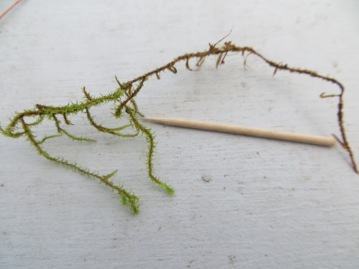
2/16/17 • Rhytidiadelphus squarrosus, next to 2″ toothpick;
Rhytidiadelphus squarrosus • known as springy turf-moss in the United Kingdom, and square goose neck moss in the United States. Other English common names: Square Shaggy Moss, Bent-leaf moss (Canada)
Rhytidiadelphus squarrosus • コフサゴケ • kofusa goke. Grows on Hokkaido, Honshu, Shikoku. R. squarrosus and R. triquetrus are related. コ often indicates a small, more diminutive form of something, フサ refers to its springy, fuzzy characteristic.]
The specific epithet squarrosus refers to the leaves, which are squarrose (Latin squarrosus = rough or scaly), having a right-angled bend which causes the tips to extend away from the stem
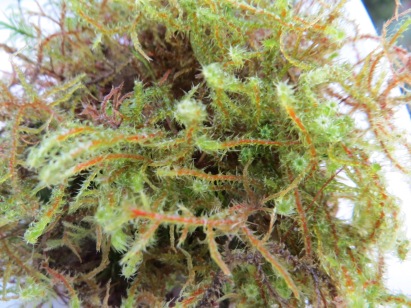
2/16/17 • Rhytidiadelphus squarrosus; pale green leaves on reddish stems
Rhytidiadelphus squarrosus, a very common moss – soft, pale green to green with yellow tones – grows as an extensive mat of branching red stems, up to 15 centimeters (6 in) tall, sheathed in leaves that are 2–2.5 mm (0.08–0.10 in) long and bend sharply back at a right angle, and thus spread outwards from the stem. The leaf bases are broad and include a pair of short nerves. The plant rarely produces capsules, so most of the species’ reproduction is asexual.
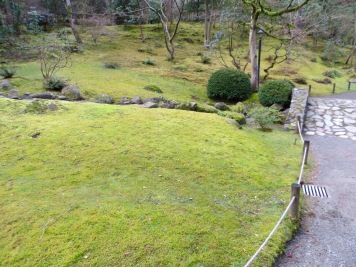
SJG • 2/14/17 – Area Z hill, where R. squarrosus grows
Habitat: square goose neck moss has broad ecological tolerances, and is usually found in man-made habitats such as lawns and golf courses. Open brushy areas, exposed to moderately-shaded soil, humus, decaying wood including that in forested swamps, grassy disrupted areas such as grazing land, lawns, beside roads and trails; residing in acidic and basic conditions.
Distribution: Rhytidiadelphus squarrosus has a circumpolar distribution in the Northern Hemisphere, being found across much of Eurasia, and parts of North America, including British Columbia, Alaska, Washington, Oregon, Newfoundland and Labrador and Greenland.
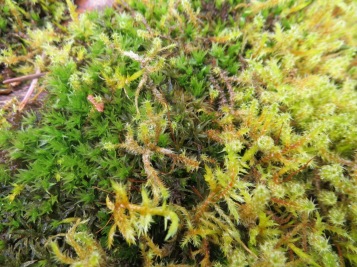
SJG • 4/1/17 – Atrichum undulatum (L) next to Rhytidiadelphus squarrosus in Area Z
It has also been introduced to northeastern North America, Tasmania and New Zealand, where it is now an invasive species.[8] The first specimen to be collected in the Southern Hemisphere was taken in 1974 in Dundas Creek, western Tasmania, but the first published record came the following year, from a golf course in Dunedin on New Zealand’s South Island.
In Washington State, there are four species of Rhytidiadelphus:
– Rhytidiadelphus triquetrus
– Rhytidiadelphus loreus
– Rhytidiadelphus squarrosus
– Rhytidiadelphus subpinnatus
R. triquetrus vs R. squarrosus (we have both of those mosses in our garden, mostly in W):
R. triquetrus is often conspicuous, with tall, tough, erect stems from which branches arise irregularly to give a bushy habit; the leaves are large and spreading, and capsules are rarely formed. It is found mostly in woodland clearings. R. squarrosus is a smaller moss with rough/scaly (squarrose) leaves; the shoot top tips have a characteristic star-burst appearance. It is found in moist grassland and is a common weed in lawns.
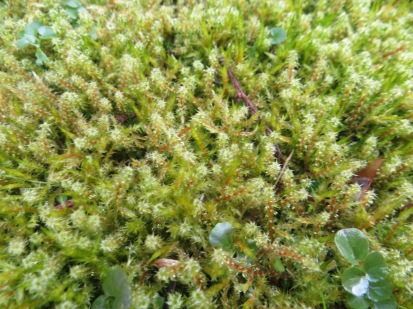
SJG • 2/14/17 – mat of R. squarrosus in Area Z
SJG notes: Rhytidiadelphus squarrosus is a very common moss, probably not cultivated on purpose in the Seattle Japanese Garden, yet it appears in several places: in the Tea House Garden, in the lawn where the Orchard grows, and sadly overtaking the large field of Calliergonella cuspidata (spear moss) in Z; as of this writing the field in Z is roughly half spear moss and half square gooseneck moss, mixed together (it doean’t change the moss appearance from the path, because the mosses are close in color (pale/light green) and height.
Polish species name of Rhytidiadelphus squarrosus is fałdownik nastroszony.
References and related reading:
• Description and picture of bent-leaf moss from the Central Coast of British Colombia
• Description, drawing and B.C. distribution map of R. squarrosus from E-FLORA B.C.
[…} Comments:
This is one of the most frequent lawn pests in cities and towns near the coast; its growth is enhanced through late-season lawn mowing and fertilization, since it grows during the wet winter when the grass is dormant. […]
• Very informative entry on the R. triquetrus from University of British Colombia blog
• R. squarrosus description from Montana Field Guide
• R. squarrosus description in Flora of North America (link to world distribution map and Chinese name)
• Literary reference:
‘The signature of all things’ by Elizabeth Gilbert is a literary/historical fiction and a feminist fable. The story of a fictional 19 century student and writer of books about mosses, Anna Whittaker, is peopled with actually living then characters: Sir Joseph Banks of Kew Gardens, Captain Cook and an assortment of scholars of plant life and nature. Here is a link to National Geographic interview with the author, in which she reveals that the bryologist Robin Wall Kimmerer was consulted on accuracy of the moss science in the book.
In the book, beneath the magnifying glass, Alma ponders the world of mosses (p.116): ‘[…] Moss grows where nothing else can grow. It grows on bricks. It grows on tree bark and roofing slate. It grows in the Arctic Circle and in the balmiest tropics; it also grows on the fur of sloths, on the backs of snails, on decaying human bones. Moss, Alma learned, is the first sign of botanic life to reappear on land that has been burned or otherwise stripped down to barrenness. Moss has the temerity to begin luring the forest back to life. It is a resurrection engine. A single clump of mosses can lie dormant and dry for forty years at a stretch, and then vault back again into life with a mere soaking of water. […].

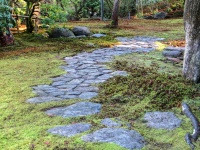
I’d like to make my lawn of Rhytidiadelphus squarrosus; do you know anywhere I can buy it?
LikeLike